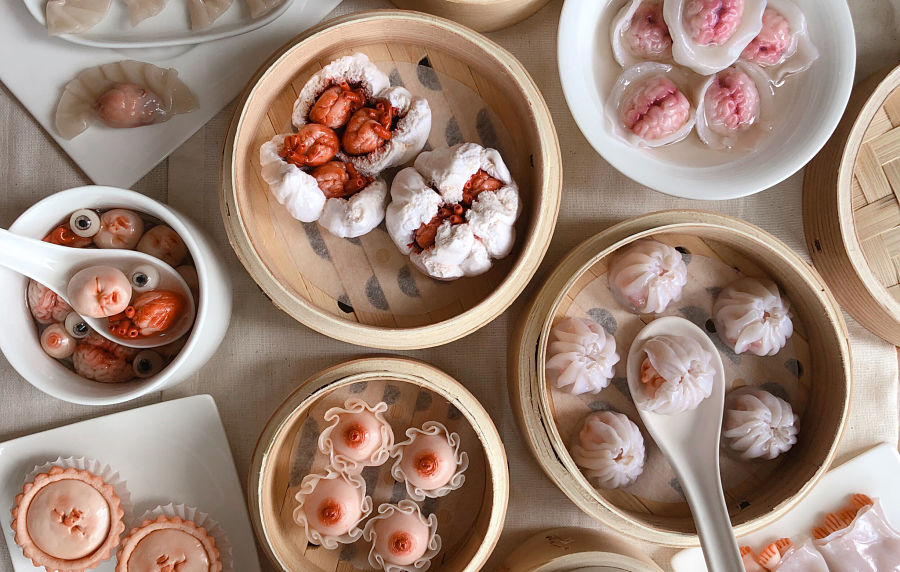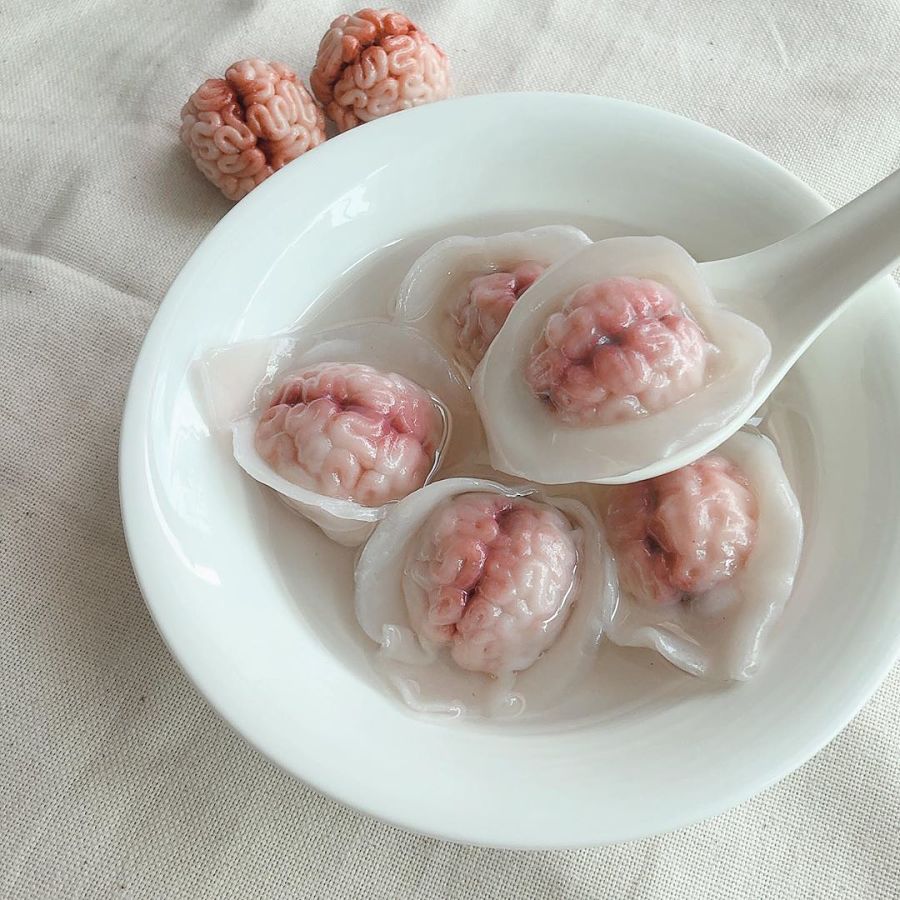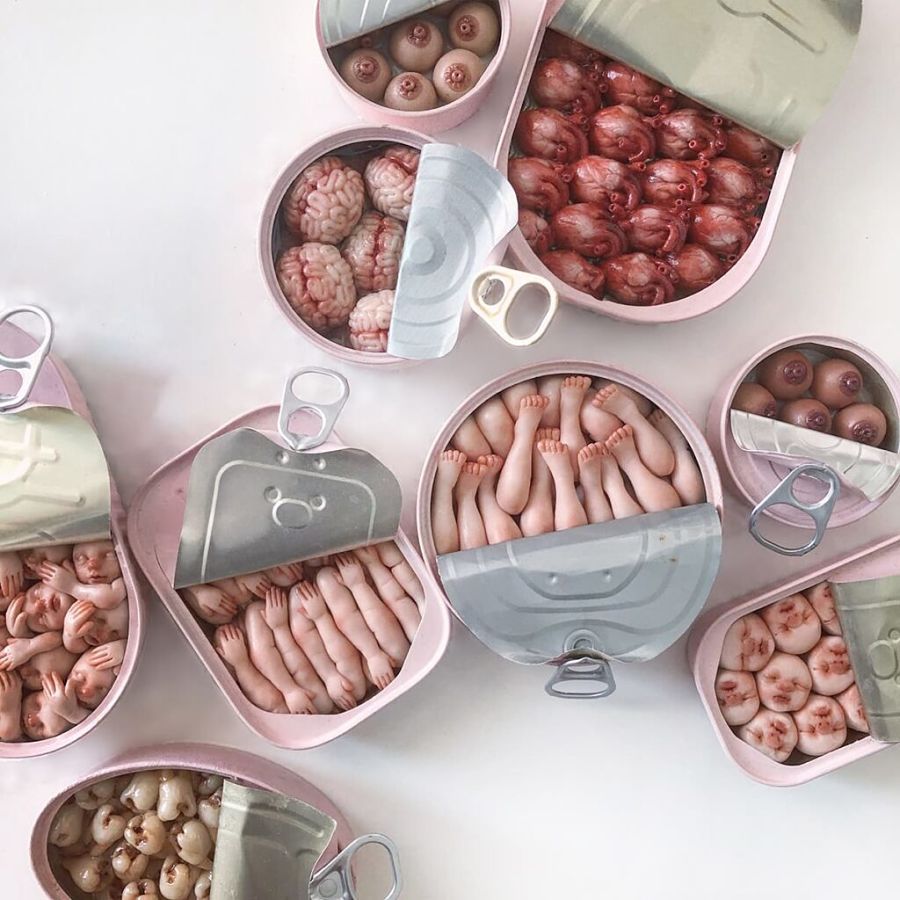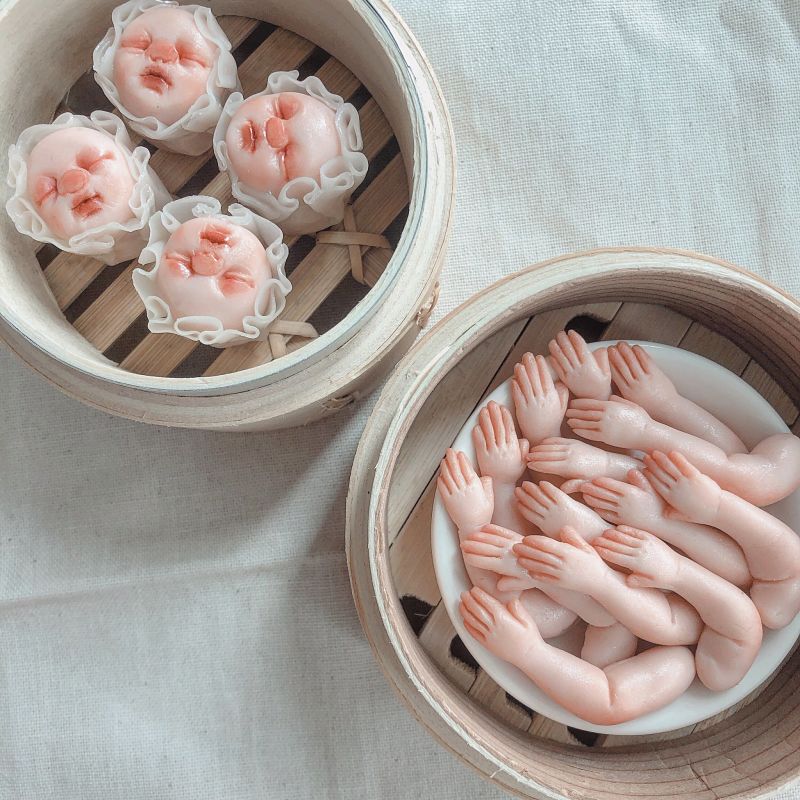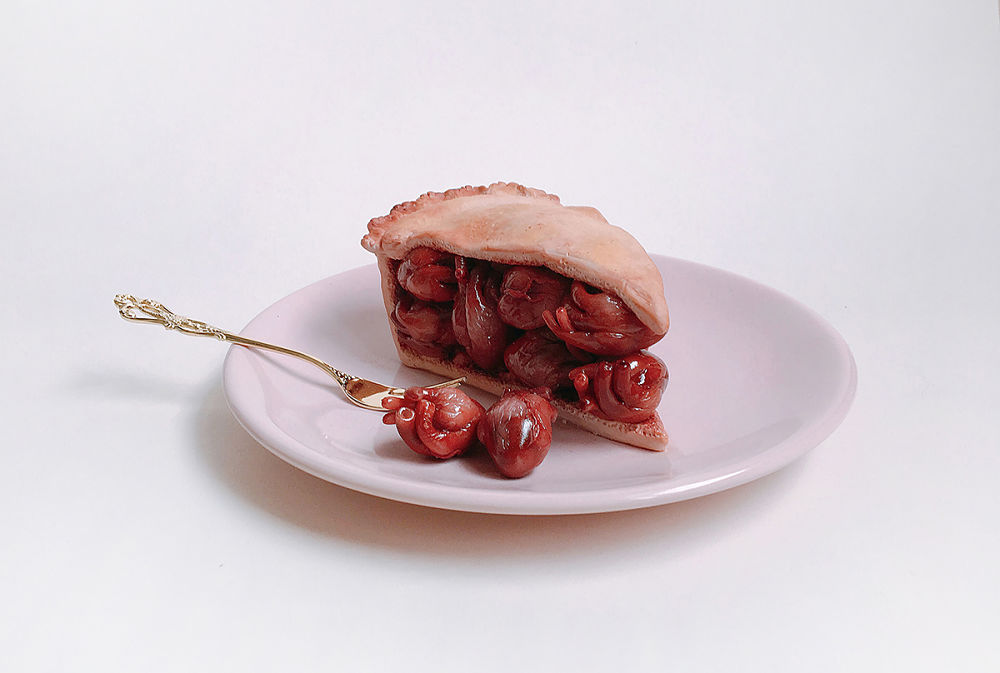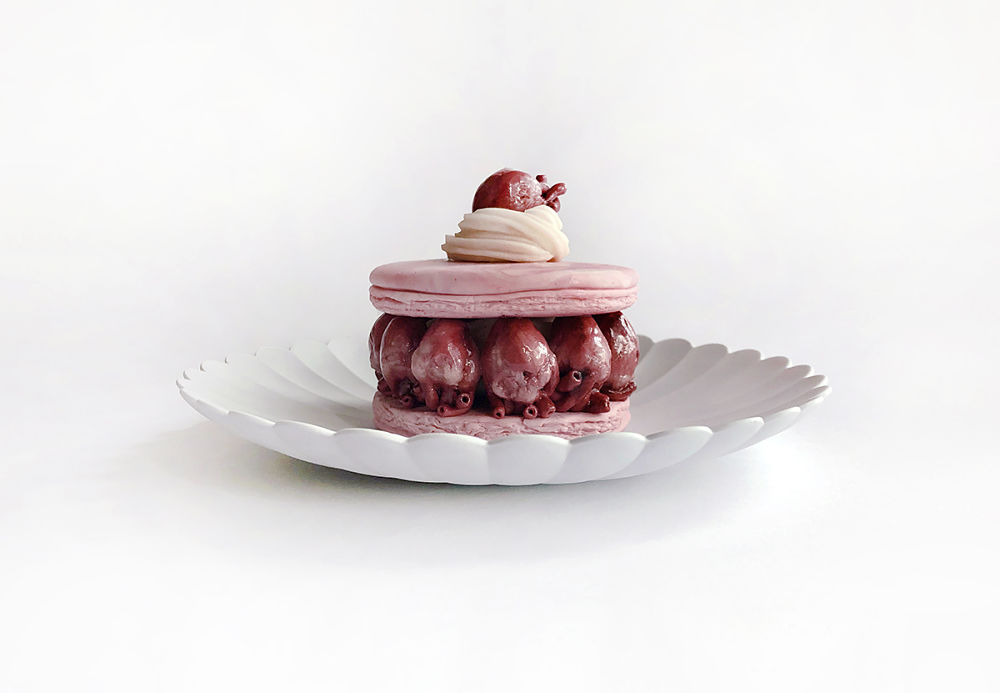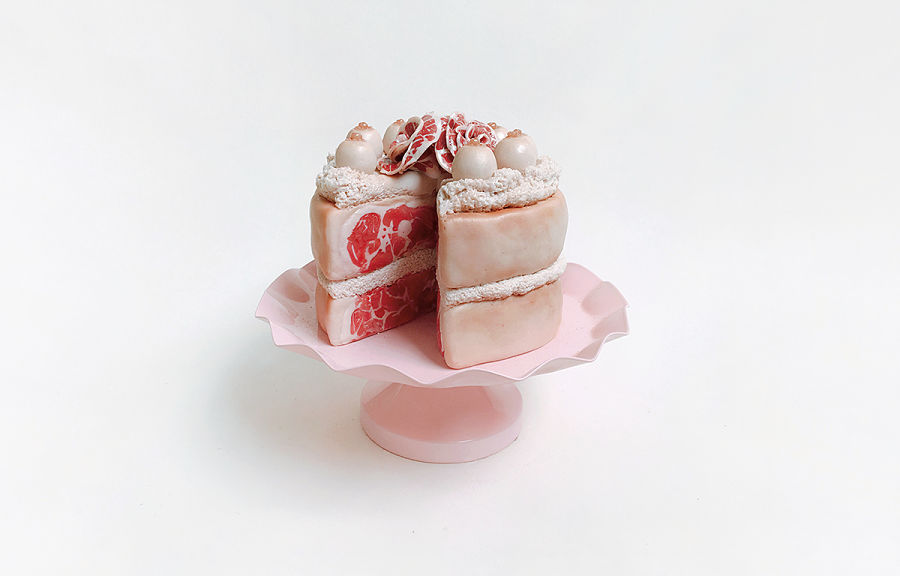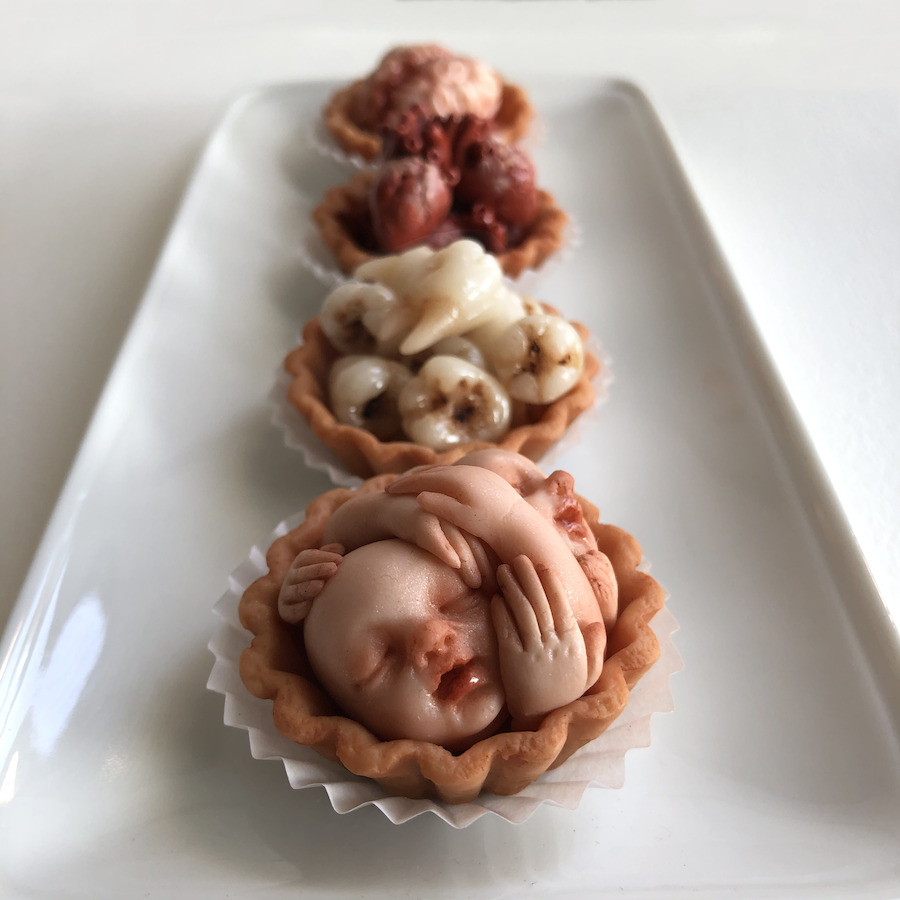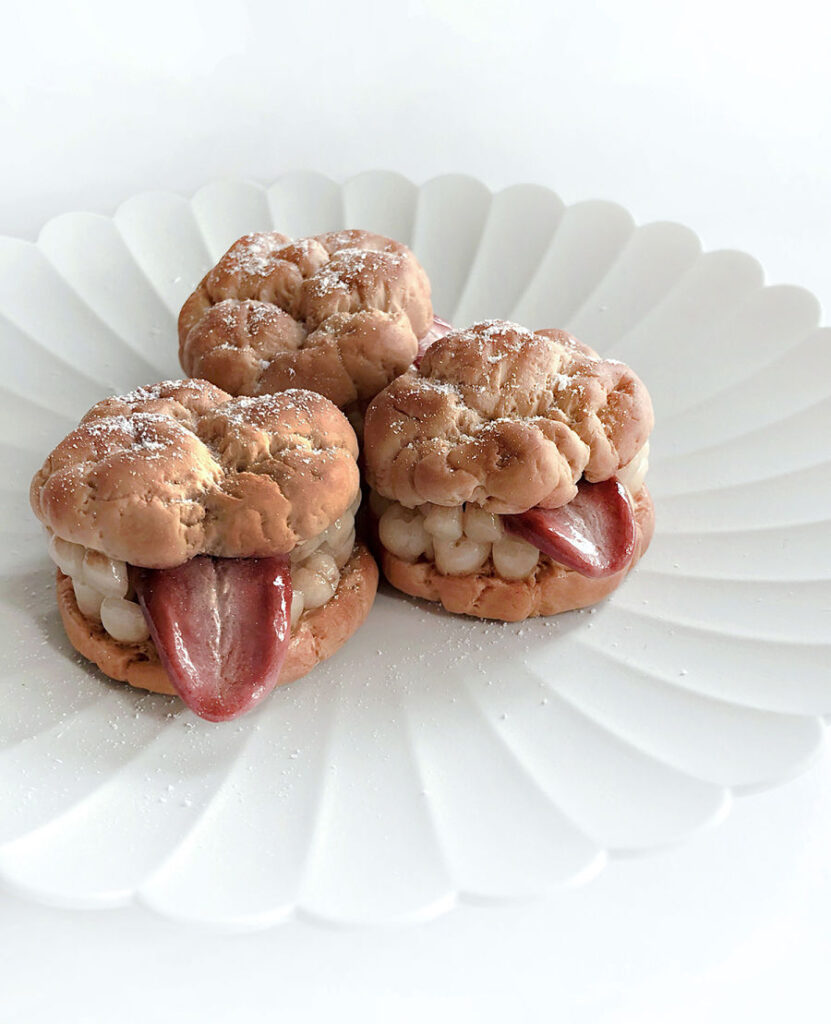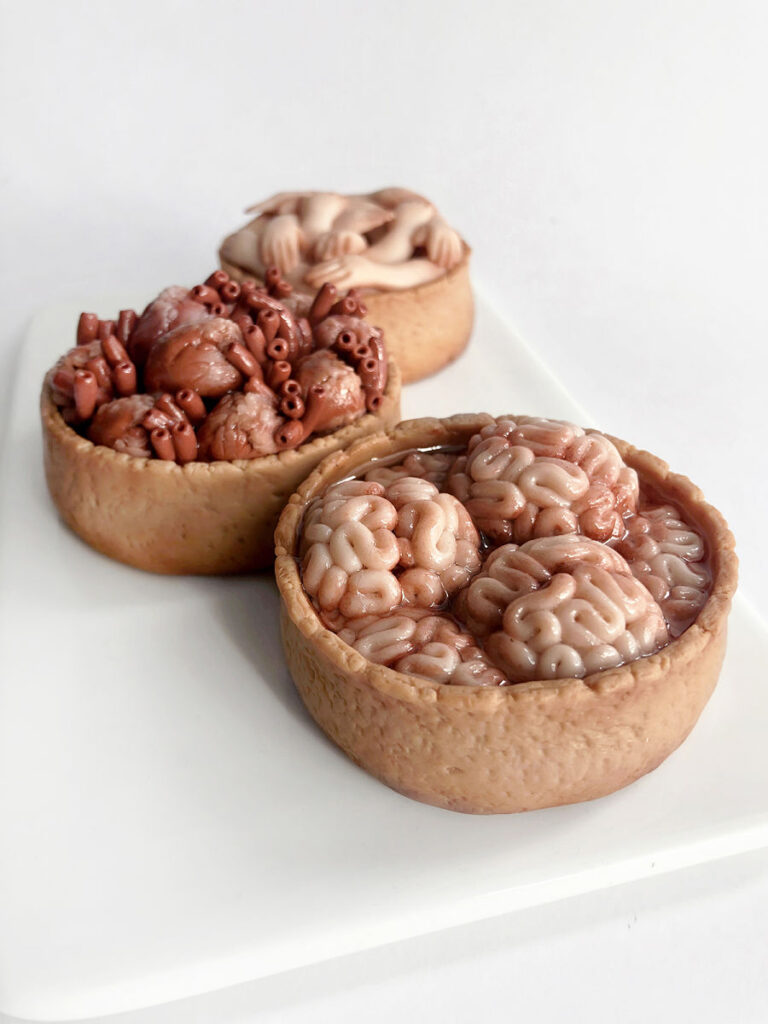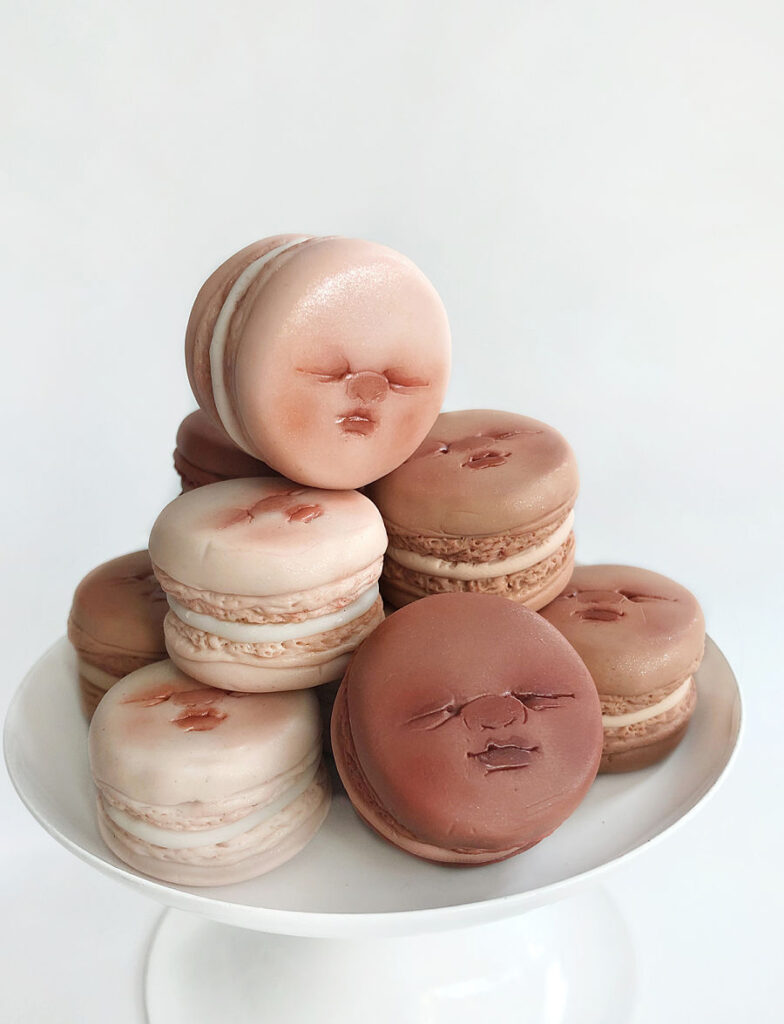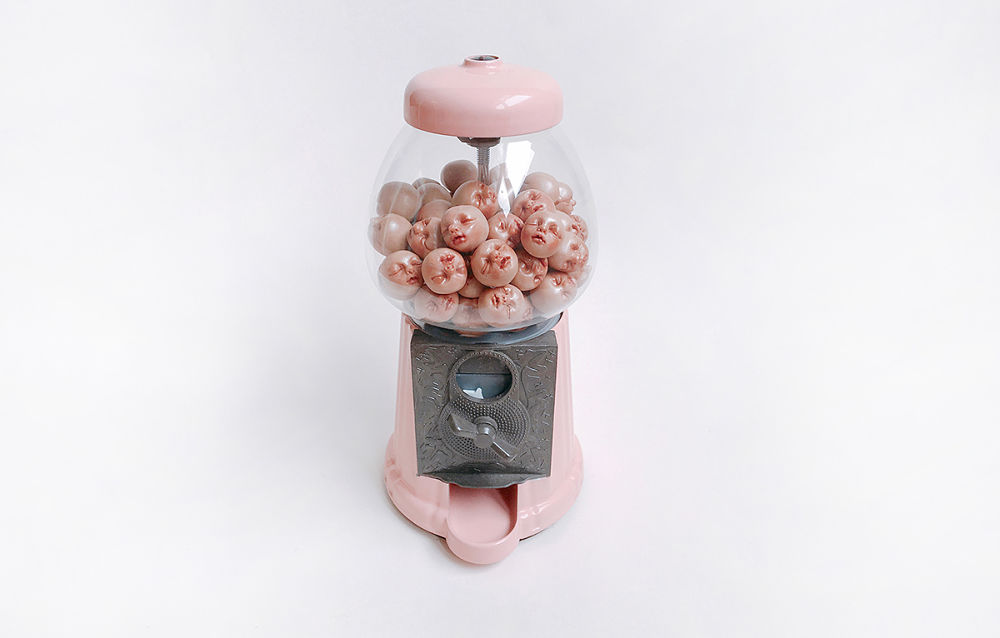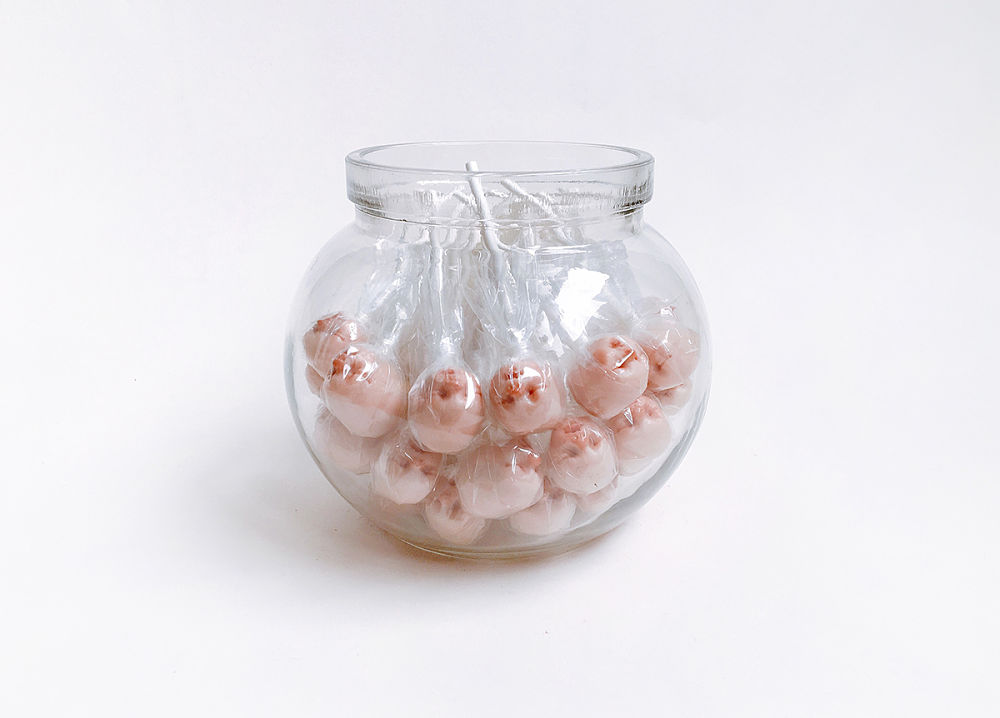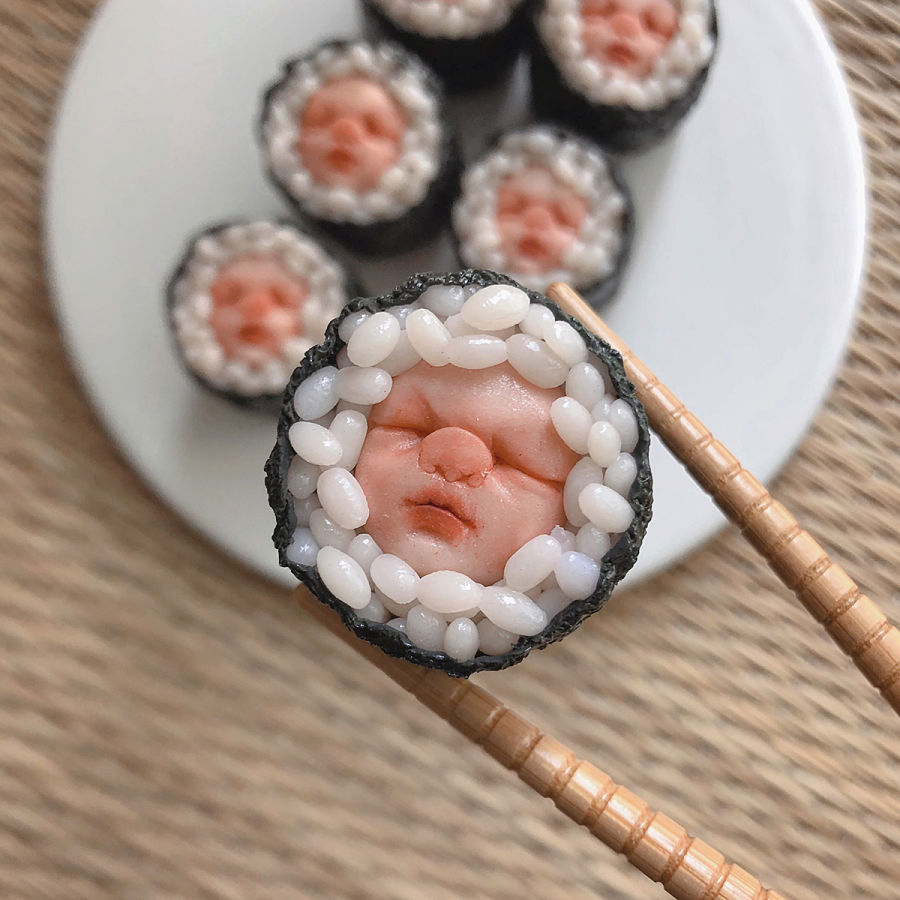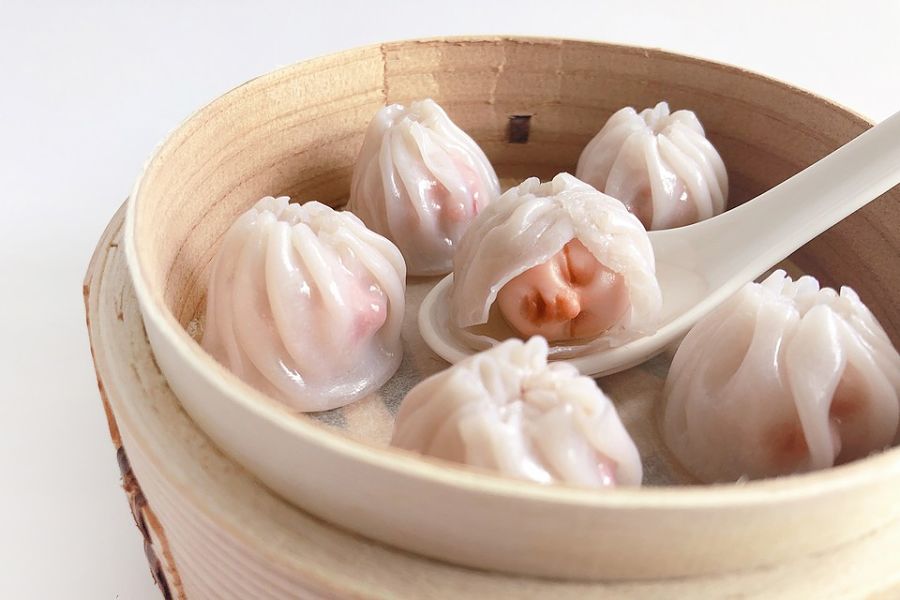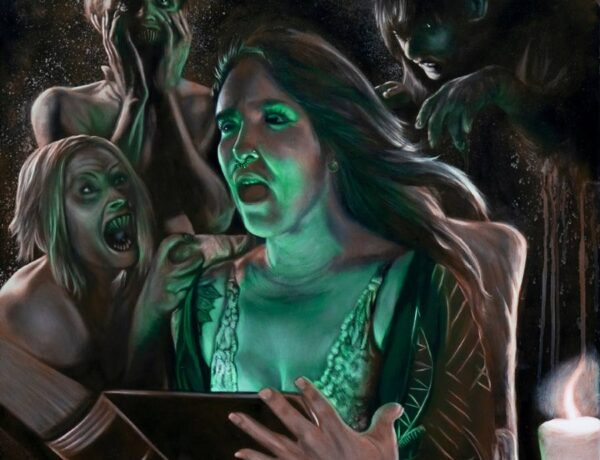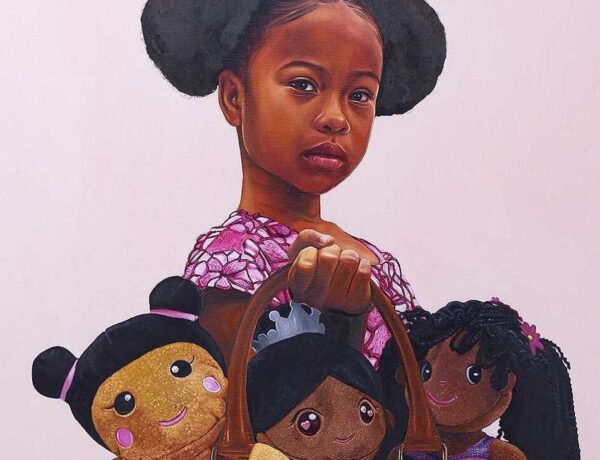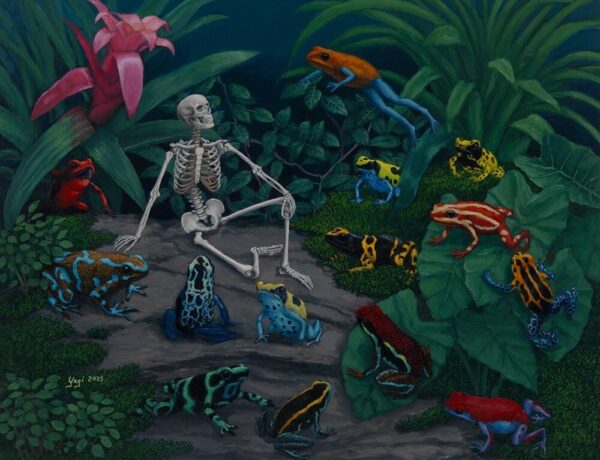Squishy cherub-like faces sit tightly packed in a pastel pink sardine tin. Their tiny faces sleep peacefully as they lie next to their infant brethren, allowing anyone viewing the sculpture to melt into a state of both serenity and horror. An array of teeth stack next to a human tongue that protrudes from a fluffy scone topped with sugar. The wetness of the tongue and the shine of the teeth are frighteningly realistic to behold. A fresh slice of pie sits with its golden-brown pastry ever so carefully placed onto a clean plate. Blood red hearts seeping out onto the plate wait to be devoured. This isn’t some kind of nightmare, this is the beautiful, twisted, and often misunderstood world of QimmyShimmy.
Qixuan Lim better known online as QimmyShimmy is a Singaporean artist and self-proclaimed “accidental sculptor”. The UX designer by day, artist by night creates sculptures oozing with pop surrealism and creepy cute aesthetics. Using polymer clay as her main art medium, QimmyShimmy mixes purity and innocence with darker and rawer imagery to blend the ordinary with the extraordinary.
I achieve a sense of visual surrealism by taking the familiar and turning it into something strange and surprising.
Graduating from the School of Art, Design and Media at Nanyang Technological University in 2014, Qixuan Lim fell into the world of creating weird and wonderful sculptures after many years of trial and error with various art mediums. Her work takes messier imagery including food and the human anatomy presenting them in a clean and sterile manner as if ready to be served in a quaint cafe. While QimmyShimmy often keeps the meaning of her sculptures ambiguous, her work is often recognized for challenging topics including beauty standards, consumerism and the meat industry. Since 2016, QimmyShimmy’s thought-provoking sculptures have been exhibited around the globe.
Interview with QimmyShimmy
To begin this interview, can you tell me about your artistic process and how you develop an initial idea into a fully formed sculpture or series of sculptures?
I achieve a sense of visual surrealism by taking the familiar and turning it into something strange and surprising. Because of that, it is most common for me to get my inspiration from everyday things and activities – for example, a trip to the supermarket and the patisserie inspired my Canned and SweetTooth series respectively. I get excited when I am surrounded by beautiful colours and textures, and it gets me thinking about how I can turn some of these everyday familiarities into something truly unexpected and surprising.
You use polymer clay to sculpt your pieces. Do you have any favourite brands or tools that you gravitate towards?
I like going back to Premo or Sculpey clay, but with the Covid-19 pandemic, and art stores running low on stock, it forces me to be a little bit more open with trying new things. I am trying out the Cernit brand now, and am liking it so far!
Has your sculpting process or any of your techniques changed since you first started? If so, how have things changed?
Hmm! I think the technique is still largely the same, but I am definitely more selective with the “props” that I use with my art now. In the past, I was happy to use cheap-looking plastic or paper toys from a store to make my art so long as it conveys my idea, but I will never do that now! The reason for that is as I become more serious as an artist, I put more care into the overall presentation and the need for the works to age well with my collectors.
What is your favourite thing about sculpting and why?
That I can work with my hands! Because I work full-time as a designer, and a large part of my time is spent working in the digital sphere. Whereas sculpting helps me ideate and create a physical object. Just being able to feel and shape and the actual material is so therapeutic, and the results are always more satisfying as well.
What is the most challenging part of the sculpting process and why?
Not knowing whether it will crack on me at the last minute! Polymer clay is a fairly predictable material to sculpt with when the work is small, but once the sculpture reaches a certain size or thickness, knowing how to bake it becomes a little more tricky. I have lost days and weeks of work because of cracking after baking, and it is absolutely heartbreaking. Of course, knowing that the work is fragile makes me extra paranoid when they are being shipped! There is quite a bit of planning and logistics involved when shipping a fragile, three-dimensional object abroad. Regardless of how reliable the courier service is, it’s always stressful.
Being able to accept discomfort means that you are open to having your perspective challenged.
What does an average day look like for you as an artist, considering you work full-time?
I work as a UI/UX designer, so I spend heaps of time in front of a screen – multiple screens, in fact! I usually wake up quite early (voluntarily, cause my body clock never lets me sleep in) and spend the mornings reading or listening to design podcasts. Then, I start work and end only in the evenings. I usually spend the evenings with my family or friends, have a simple dinner, take a walk, and curl up in bed with a nice film. I have always been a homebody and like spending a lot of time at home, and the pandemic restrictions have definitely helped me embrace it even more.
Do you have a favourite piece of work that you have created? If so, which one and why is it your favourite?
It is really hard picking a favourite! I usually have a few pieces I am proud of from every series I made. But if I have to choose only one, it would be Gumball, 2017 from my SweetTooth series, for it is the work that really helped me define my style. I showed it once in Singapore and another time in the Netherlands, and is now owned by an amazing tattoo artist in Seoul, Oozy (@oozy_tattoo). I think that work was a huge turning point for me because I saw the potential in where my art could go.
You receive quite polarising opinions online but do you find you receive similar responses in person when you exhibit your work?
Never! I think people are much bolder online – in real life, even if someone dislikes my work, he/she/they will not say it to my face. And fortunately, my works have always been exhibited with galleries that have established a niche audience, so the people who walked in and spoke to me are always lovely and appreciative. The ones who will find my works extremely offensive will never find themselves walking into these galleries.
Have you had any funny or unusual encounters when showcasing your art?
One of my earlier works was of a dog foetus sculpture enclosed in a jar. I was much more experimental back then, so I actually used my own cut fingernails to create little claw details. I had two visitors staring at the sculpture really closely, marvelling at the details of its claws, when I crept behind them and said “those are actually my fingernails”. They gave me a really awkward smile and slid away sideways without saying a word. Looking back, I shouldn’t have done that but it still cracks me up today!
I would rather a piece of art be cherished by an intentional collector than forgotten in the dusty shelves of a hundred.
You have expressed before that you like the quote, “Art should comfort the disturbed and disturb the comfortable”. Do you think that the art world and wider society need more art that challenges our ideas of beauty and comfort?
Yes definitely! In this age, when everyone wants to have an opinion on everything, it is extremely important to remind ourselves that life is not about taking sides or perpetuating the narrative that the world is either black or white, wrong or right. The world is grey and constantly in flux, and as a result, we live in the dualities of comfort and discomfort. Being able to accept discomfort means that you are open to having your perspective challenged, and it is necessary to help us think more critically and evolve into better people.
When you first began your journey as an accidental sculptor, did you wonder about the kind of reception you might receive from people about your art?
Not at all! I did not even think that anyone would care for it (or hate on it)! I started out showing my works in very small local pop-ups and posted for 400 followers on Instagram, and I was happy with that. It’s always fun and affirming to have people notice and appreciate your art, so I am always thankful that I took the time to discover and hone my practice. Of course, the reception is not always positive, and I am okay with that as well. I think everyone is entitled to their opinion, even if it is different from mine.
You’ve expressed before that you are selective about selling your art and don’t like the idea of it being mass-produced. Is this because you feel a strong connection to your art?
I am lucky because I do not need to depend on my art to make a living, so I can actually have a choice in not wanting it scaled commercially or having it mass-produced. I don’t think the reason stems particularly from having a strong connection to my art, but more so of disliking the idea of mass production and consumption. I would rather a piece of art be cherished by an intentional collector than forgotten in the dusty shelves of a hundred. I like the idea of objects being precious that it is unique in the world and representative of a time in my life – something that mass production can never capture or emulate.
Alongside your sculpting work, you also do illustration. Can you tell me a bit more about that?
I was a Visual Communications major, so learning how to draw and illustrate is part and parcel of the program. I love illustration, and for a large part of my schooling days, I aspired to be a children’s book illustrator. I always loved the dark and romantic writing style of Brothers Grimm, Hans Christian Andersen and Edgar Allan Poe, and aspired to illustrate books like Tim Burton’s The Melancholic Death of Oyster Boy and Other Stories. I was freelancing for a couple of years, so it gave me the space to explore illustration commercially. Of course, after taking the full-time UX route, illustration had to take a backseat for my sanity. It is a huge pity to let go of it, but I don’t think I can juggle anything more than what I have now – a full-time design job, a stint as a part-time lecturer, and an art practice on the side. And to be very honest, I don’t think I have found my voice yet in this world as an illustrator and I never had the time to hone it. The retirement dream is to go back to it and probably achieve this goal somehow.
When you aren’t working and creating art, what do you like to do in your spare time?
I like reading a mix of fiction and non-fiction books. I love urban fantasy and science fiction and am currently going through the Dune series. For non-fiction books, I usually read about design and technology, and the occasional AI/ML stuff because that is related to my work. If not for Covid-19 restrictions keeping me home, I also like playing Dungeons and Dragons with my friends over a glass of wine.
Do you have any exciting projects coming up soon that you can share with our readers?
I have a small solo coming up in Melbourne with one of my favourite galleries to work with, Beinart Gallery, scheduled for October 2021. I usually try to do at least three shows a year, but I am taking this a little slower now due to the Covid-19 pandemic. I like travelling to my shows, so not being able to do that is a big bummer. I am taking the time to slow down and find new ideas, and hopefully, when the world is somewhat back to “normal”, I will get back to travelling and showing more.


